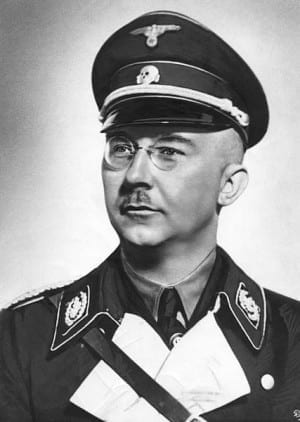Himmler and Otto Rahn's Cathars

Once a faithful Roman Catholic, Heinrich Himmler rejected religion at about the time that a parliamentary decree robbed him of his aristocratic title. Stripped of both his faith and social status simultaneously, Himmler, like the fictional Dieter Bachman of The Blood Lance, threw himself passionately into the Nazi cause. At the same time he became interested in all aspects of the occult.
Himmler does not seem to have been an especially brilliant man but he was educated, sophisticated, and notoriously energetic. As the leader of the SS, he oversaw the activities of the Gestapo; he ran the concentration camps; he provided Hitler ultimately with twelve divisions of elite armoured troops, and he built a massive civilian organisation devoted to German culture. It oversimplifies matters to suggest the SS was Hitler's Praetorian Guard, with Himmler in the role of Tiberius' Prefect, Aelius Sejanus. Likewise, it misses much of the complexity of the SS to say they are like the Knights Templar of the Crusade era. The similarities between the two organisations are probably not accidental, but it was the civilian side of the SS that made the Order of the Skull Himmler's own creation. It was into the civilian branch of the SS that Himmler recruited Otto Rahn.
According to Rahn's account of the matter, given to a friend during the 1936 Olympics, Himmler had read Rahn's book and, as an anonymous patron, invited him to Berlin. When Rahn appeared one afternoon, Himmler offered him a position without any responsibilities with a salary equal to that of an SS captain. The oddity of this for me was that when I read The Crusade Against the Grail I was struck by Otto Rahn's liberal sympathies. The society he celebrates is nothing like that of Germany in the mid-1930s. Indeed, it was a long time before I could even speculate about Himmler's interest in the book.
Himmler's enthusiasm for the book and it was significant—he promoted it amongst his staff as a 'must read'—is perhaps to be seen in the coincidence of the Cathar ideal of knighthood and Himmler's own developing vision for his SS. The ideal Cathar knight, as Rahn described him, was expected to be accomplished in all aspects of human endeavour—not just military prowess. In the mid-1930s Himmler was developing an elite fighting force for Hitler, but those who wore the ring of an SS officer were also expected to be gentlemen of intellectual and artistic accomplishment as well. In the early years, the SS had its pick of the military recruits, but Himmler personally went out and recruited from the disenfranchised aristocracy and moneyed classes. He also sought out intellectuals from various disciplines who were sympathetic to the new order. To serve in the SS was to embrace a number of ideals. Some of these ideals were eventually corrupted, and some were wrong-headed at the beginning.
In addition to the idealised knighthood that Rahn described in the book, I expect Himmler was ultimately drawn to Rahn's book because it presented a corrupt Papacy and a greedy French monarchy. Against such villainy the Cathars kept faith—choosing death by fire rather deny their faith.
The irony of all this is that what Otto Rahn admired the most in the Cathars was their liberality, especially their ability coexist and even intermingle with the Jews; this in stark contrast to medieval society in general. Himmler seems not to have noticed this aspect of the book, or perhaps he wrote it off as a minor flaw in an otherwise inspiring book.
CRAIG SMITH, The Blood Lance (2008)
- Inicie sesión o regístrese para enviar comentarios
Similar By Terms
|
(English)
|
(English)
|
(English)
|
(English)
|
|
(English)
|
(English)
|
(English)
|
(English)
|









Comentarios recientes
hace 13 años 44 semanas
hace 13 años 45 semanas
hace 13 años 45 semanas
hace 13 años 45 semanas
hace 13 años 48 semanas
hace 14 años 2 semanas